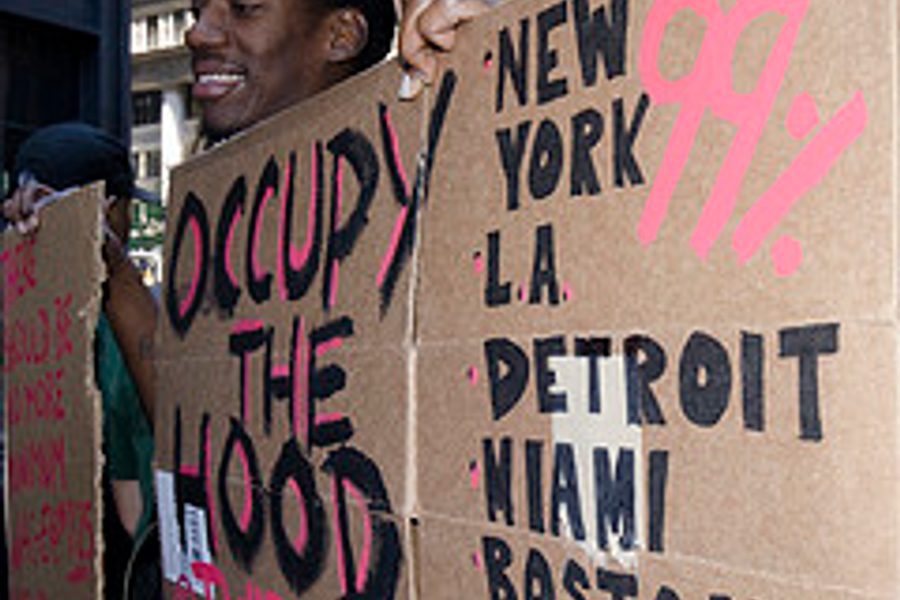
MILWAUKEE — The “We are the 99%” message of the Occupy movement has provided a unifying umbrella under which people of widely-varied backgrounds can connect their experience of America’s appalling economic and social inequality.
One of the most interesting offshoots of the Occupy movement has been the national emergence of the “Occupy the Hood” movement composed of young African-American and Latino activists. They have expanded the movement’s range of concerns beyond the politically-safe theme of the shrinkage and downward mobility of “the middle class,” by addressing the issues of “working-class and poor people,” explained Kahlil Coleman, 25, a leader of Milwaukee’s “Occupy the Hood” chapter.
“You look at cuts in jobs, schools, services, and it’s mainly affecting the bottom of the bottom of the 99%,” Coleman declared.
Exemplifying its focus on empowering the poor and pushing for new family-sustaining jobs, Occupy the Hood led a multi-racial crowd of 400 mostly young people on October 29 to the site of the former AO Smith (later Towner Automotive plant) to protest the flight of family-supporting jobs from Milwaukee and to simultaneously spotlight SB 207, a repressive piece of new state legislation that , in the words of Milwaukee School Board member Larry Miller, “gives employers the right to legally discriminate against over 62,000 Wisconsin residents.”
MORE JOBS WOULD BE CLOSED OFF TO PEOPLE OF COLOR
“The bill would enable employers to reject job applications of convicted felons even if there was no connection between the offense and the responsibilities of the job, and would further allow them to fire current employees with felony records, Coleman said.
Despite its progressive reputation, Wisconsin’s jails and prisons contain a proportion of African-American males that is among the nation’s very highest. The proposed law would add new barriers to employment for African-American males, when unemployment of 60 percent or more prevails in Milwaukee.
The former AO Smith plant — a giant wasteland of ghostly, empty buildings and vast, weed-grown parking lots — symbolizes the destruction of opportunity on a massive scale.
The site holds enormous significance for the African-American community. At one point, the unionized auto-frame plant supplied 7,800 high-paying jobs, providing incomes that lifted thousands of African-American families into “middle class” living standards.
But beginning in the 1980s, AO Smith began shifting more and more of these family-supporting jobs to Mexico, converting them into mere subsistence-level jobs for desperate Mexican workers in cities like Ciudad Juarez. By 1991, Smith employed more workers in Mexico than its home base of Milwaukee. Tower Automotive bought the Milwaukee plant, and it shipped the last 500 jobs to Mexico in 2004.
“It left behind a giant ‘Dust Bowl’ in the middle of the community, with the result being much more youth violence, high infant mortality, and the closing of many other factories, shops, and restaurants,” said Coleman. (The Milwaukee Journal Sentinel recently ran a major article focused on the Third-World level rate of infant mortality in the area, called “Where city factories, and now babies, die.“ However, the Journal Sentinel refrained from drawing the obvious conclusion that the factories and their jobs were killed off through conscious decisions by the top 1 percent, rather than just mysteriously disappearing.)
The vacant factory space held promise a year ago as the new site for manufacturing mass-transit rail equipment by the Spanish firm Talgo for a new fast-rail route between Milwaukee and Madison. But ultra-reactionary Gov. Scott Walker, now the target of a fast-growing recall campaign that has already gathered 300,000 petition signatures of the 540,000 needed to call for a new election, turned down more than $800 million in federal funding for the route, crushing the dreams of Milwaukee residents desperately hoping for an upturn in job opportunities.
The building and maintenance of the rail plan and its equipment would have generated between 5,000 and 13,000 jobs.
READY FOR THE LONG HAUL
For Occupy the Hood, the march to the Smith site and subsequent activities have illustrated its mission of both fighting concrete legislative battles of immediate importance to the African-American and Latino communities and performing educational outreach about the root causes of widespread misery in these communities. The deindustrialization of Milwaukee — which has lost 80 percent of its factory jobs since 1977 — has had a devastating impact particularly on people of color.
Occupy the Hood envisions a long-term strategy in educating and activating the African-American and Latino communities as full partners in the broader Occupy movement, Coleman stressed. “We want to be reaching more of the masses. How do we galvanize those people who won’t show up a mass meeting?”
Milwaukee’s communities of color (the city is 40% black, 16% Latino), already in desperate shape before the last four years of ongoing high unemployment and wage-cutting, are hungry for fundamental reforms that improve their lives, but need to see proof that the Occupy movement is serious and does not serve as a political vehicle for any politician. “People want to be part of something where they can say, this really represents my interests,” observed Coleman.
“In some ways, the [African-American] community is more solid than Occupy movement itself” in its readiness for a massive movement challenging inequality, Coleman said. “People are so eager for change, but they’re not sure if this is going to be the movement that will represent them. For example, how do you keep it from being something traditional run by a politician?”
These are questions that will have to be answered over the long haul, Coleman readily admits. “The main thing is to build something long-term. After all, we are up against a system that runs most of the world,” a reflective Coleman stated.








